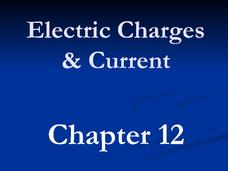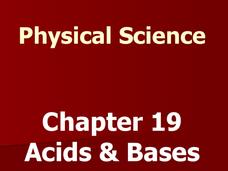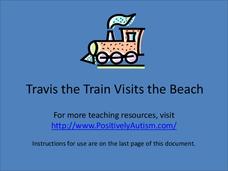Mr. E. Science
Energy and Power
Teens often display potential energy in class and kinetic in the hallways. This third presentation covers the six types of energy, each in potential and kinetic form. It also covers the Law of Conservation of Energy and Einstein's Theory...
Mr. E. Science
Characteristics of Waves
Waves, waves, and more waves. Here, class members look at the many types and characteristics of energy waves including transverse, longitudinal, standing, seismic, p-waves, s-waves, and l-waves.
Mr. E. Science
Electric Charges and Current
Resistance is not futile, it is voltage divided by current. The presentation goes in depth covering electric charges, conductors, insulators, electric fields, static charges, and circuits. The lesson is the 12th in a series of 26.
Mr. E. Science
Electricity and Magnetism at Work
I don't get electricity jokes, watts so funny about them? The 13th in a series of presentations covers energy, motors, currents, generating electricity, calculating electrical energy cost, transformers, and batteries.
Mr. E. Science
Magnetism and Electromagnetism
The biggest magnet in the world is at the Los Alamos National Laboratory in New Mexico and can reach 100 tesla. By comparison, magnets that lift cars are about two tesla. The 11th presentation in this series covers magnetism, focusing on...
Mr. E. Science
Changes in Matter
Do solids, liquids, and gases even matter? The presentation focuses on changes in matter, including phases, Boyle's Law, Charles' Law, and physical changes.
Mr. E. Science
Light
Where does bad light end up? In a prism! The presentation covers light, mirrors, lenses, and the structure of the eye. It also provides explanations of reflection, refraction, concave and convex mirrors and lenses, and a comparison of...
Mr. E. Science
Acids, Bases and Solutions
If you are not part of the solution, then you are part of the precipitate. The presentation covers solutions, suspensions, solubility, dissociation, and acid/base reactions. This is the 19th lesson in a series of 26.
Mr. E. Science
The Earth in Space
Do you think Earth makes fun of other planets for having no life? The presentation covers the rotation and revolution of both the earth and our moon. It provides explanations for seasons, tides, and eclipses. Lesson is the 20th in a...
Mr. E. Science
Manned Spaced Exploration: From Start to Gemini
Seven percent of Americans believe the moon landing was staged. The presentation covers manned space exploration from the beginning of the space race through the Gemini missions. The lesson is the 23rd in a set of 26.
Mr. E. Science
Stars, Galaxies and the Universe
It takes 225 million years for our sun to travel around the galaxy. The presentation covers astronomical units, light years, telescopes, types of stars, the life cycle of a star, and types of galaxies. This is the last lesson in a...
Mr. E. Science
Our Solar System
The presentation starts with the scientists who made discoveries about our solar system: Ptolemy, Copernicus, Galileo, Brahe, Kepler, and Newton. It also covers the planets, inner, outer, and Pluto, satellites, and an in-depth discussion...
Mr. E. Science
An Introduction to Matter
What's the matter? Gas, solid, liquid, or plasma. The presentation covers how to describe and identify matter, changes in matter, types of matter, measuring matter, particles of matter, Democritus, and John Dalton's Atomic Theory.
Mr. E. Science
The Nature of Electromagnetic Waves
Imagine a presentation that covers electromagnetic waves, electromagnetic radiation, radio waves, microwaves, the visible light spectrum, UV, X-ray, and gamma rays. Here's one. Packed with facts and colorful illustrations, 11-slide...
Roanoke County Public Schools
Officer Buckle and Gloria Vocabulary
Vocabulary from Peggy Rathmann's award-winning illustrated picture book, Officer Buckle and Gloria, named one of the National Education Association's top 100 books for children, is featured in a colorful, presentation that not only...
University of New Mexico
Visual Supports for Students with Autism Spectrum Disorder (ASD)
Because autism manifests in so many different ways it is referred to as Autism Spectrum Disorder (ASD). No one approach is appropriate for learners with autism. The idea of this packet if to provide a variety of approaches and materials...
Woodland K12
Context Clues: You Be the Detective
A straightforward slideshow presentation explains the meaning and use of context clues when defining new words. Each slide presents an example of what context clues are, how to identify them, and how it helps reading comprehension. The...
Pearson
The Chemical Context of Life
An educational presentation includes atoms, molecules, the four major elements, as well as neutrons and protons. Additionally, slides focus on atomic number, mass number, atomic weight, polar and nonpolar covalent bonding, ionic bonds,...
Curated OER
Introduction to Poetry
What makes a poem a poem? Give your class a basic understanding of some of the different aspects of poetry by showing them a slide show of poetic devices and elements. The presentation is quite long, so you might split it up into a few...
Curated OER
The Health Triangle
What else does physical health include besides exercise and nutrition? How can I support my mental health? Does social health just refer to relationships with friends? How are all of these questions vital to the body's overall efficiency...
Savvas Learning
Political Parties
What is a political party, and what major parties exist in American politics today? How did the party system develop in American history, and how are parties organized? These questions and many other details regarding the political party...
Estrella Mountain Community College
Active and Passive Voice
Adult language learners will benefit from this 20-slide presentation about active and passive voice constructions. Learners craft active and passive voice questions in the simple present and simple past tenses.
Alvord Unified School District
Taking Good Care of Ourselves: Personal Hygiene
Freshen up your classroom (and students) with this personal hygiene presentation. Colorful images and clear language help adolescents learn about the changes their bodies are undergoing and the things they can do to ease the transition...
Positively Autism
Travis the Train Visits the Beach
Part of a unit on the seasons, in this resource Travis the Train introduces autistic learners to the ocean, beach balls, sand castles, pails, shovels, and sea shells. The final pages review the names of the images included in the lesson.
Other popular searches
- Authors Purpose Powerpoint
- Jeopardy Powerpoint
- Algebra 1 Powerpoint
- Powerpoint Math Lessons
- Powerpoint Lessons
- Science Powerpoint
- Cell Structure Powerpoint
- Powerpoint Rock Cycle
- Powerpoint Math
- Comic Strips Powerpoint
- Forensic Science Powerpoint
- Lesson Plans + Powerpoint

























